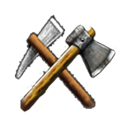-
Posts
25.684 -
Joined
-
Days Won
300
Everything posted by Lion.Kanzen
-
This was committed?
-
.thumb.png.ce58cea22940c255f5b0a735d5abee36.png)
Empires Apart. ==Freemium==
Lion.Kanzen replied to Lion.Kanzen's topic in Introductions & Off-Topic Discussion
I like these graphics, give more simple , I will love if is arcade system with advanced units development, like group order, waypoints, etc. probably this the RTS that guy @Kicking_Bird dream ( in art style) I like all kind graphic, cartoon like Cell shading. I love Cell shading like Zelda the Wind Waker or DBZ franchise. They have problems with pathfinding, like us in the early alphas.- 209 replies
-
- rts
- microtransactions
-
(and 2 more)
Tagged with:
-
.thumb.png.ce58cea22940c255f5b0a735d5abee36.png)
Empires Apart. ==Freemium==
Lion.Kanzen replied to Lion.Kanzen's topic in Introductions & Off-Topic Discussion
May be some casual audience, or newbie in RTS audience.- 209 replies
-
- rts
- microtransactions
-
(and 2 more)
Tagged with:
-
Empires Apart is an upcoming RTS that “wants to be Age of Empires at heart”, say Slitherine, who have just announced that they’ll be publishing DESTINYbit’s game when it’s ready for release in the second half of 2017. I hadn’t heard of the title until today, so I’ve been digging through old development video blogs like a digital archaeologist. You can see the three videos produced to date below, as well as an announcement trailer.
- 209 replies
-
- 1
-

-
- rts
- microtransactions
-
(and 2 more)
Tagged with:
-
.thumb.png.ce58cea22940c255f5b0a735d5abee36.png)
===[COMMITED]=== Ptolemaic Klēroukhia (Military Colony)
Lion.Kanzen replied to Stan`'s topic in Completed Art Tasks
Can be nice see it in game. -
another work, end alarm, and (almost) level up alert
-
.thumb.png.ce58cea22940c255f5b0a735d5abee36.png)
==[Task]== Tiny icons set (simple)
Lion.Kanzen replied to Lion.Kanzen's topic in Eyecandy, custom projects and misc.
preview- 79 replies
-
- lion.kanzen
- gui
-
(and 3 more)
Tagged with:
-
.thumb.png.ce58cea22940c255f5b0a735d5abee36.png)
==[Task]== Tiny icons set (simple)
Lion.Kanzen replied to Lion.Kanzen's topic in Eyecandy, custom projects and misc.
this is closet, but is from other game. (can be used to "back to work") what you think? I attached "Deault command" as place order generic for command. and Niektb's request.- 79 replies
-
- 1
-

-
- lion.kanzen
- gui
-
(and 3 more)
Tagged with:
-
Niektb you think about rank symbol is apropiated make an arrow ? that arrow can be used for upgrade single entity.
-
Probably needs some brightness the dark and the other a upgrade symbol ( or rank)
-
.thumb.png.ce58cea22940c255f5b0a735d5abee36.png)
No conversion in the game?
Lion.Kanzen replied to wowgetoffyourcellphone's topic in Game Development & Technical Discussion
Yes but , was a hacking method than gameplay feature. Even never I can try successfully. -
A mysterious video appears suddenly. is our engine? Our game? look the source evolution.
- 3 replies
-
- 1
-

-
- video
- no gameplay
-
(and 1 more)
Tagged with:
-
.thumb.png.ce58cea22940c255f5b0a735d5abee36.png)
[RESOLVED] Problem with Attack component?
Lion.Kanzen replied to wowgetoffyourcellphone's topic in Bug reports
You must wait for some features, I think and talk with team, even use the trac to expose your ideas, I will support you as contributor, and the benefits of use the feature to enrichment a mod. ----- -
.thumb.png.ce58cea22940c255f5b0a735d5abee36.png)
Where are you from?
Lion.Kanzen replied to Lion.Kanzen's topic in Introductions & Off-Topic Discussion
The sentence must be. Yo hablo muy "poco" español. pequeño is used for size only.- 332 replies
-
- localization
- country
-
(and 1 more)
Tagged with:
-
roman army camp into CC.
-
.thumb.png.ce58cea22940c255f5b0a735d5abee36.png)
No conversion in the game?
Lion.Kanzen replied to wowgetoffyourcellphone's topic in Game Development & Technical Discussion
Domestic animal capturing is a "must to do" -
.thumb.png.ce58cea22940c255f5b0a735d5abee36.png)
Is it useless at this time to create mods?
Lion.Kanzen replied to wowgetoffyourcellphone's topic in Game Modification
Probably the solution is get more team members to acces your mod code, and the excessive gameplay differences. I like those differences but you need keep updated to work under SVN. -
I have the problem with buildings ( example: Hanging Gardens structure)
-
.thumb.png.ce58cea22940c255f5b0a735d5abee36.png)
Custom scenario in multiplayer mode
Lion.Kanzen replied to Cyberpangolin's topic in General Discussion
I love that, but the team doesn't have that logistic.( IMHOP) -
.thumb.png.ce58cea22940c255f5b0a735d5abee36.png)
Autumn tree content mod
Lion.Kanzen replied to niektb's topic in Eyecandy, custom projects and misc.
Impressive -
Cleomenes III reform the army to give to them Macedonian style( Pikemen) https://en.m.wikipedia.org/wiki/Cleomenes_III
-
Nice color player. ----- how work your defense tower mod?
- 15 replies



